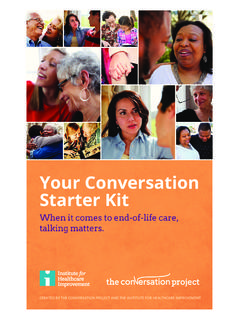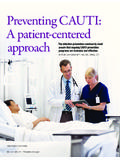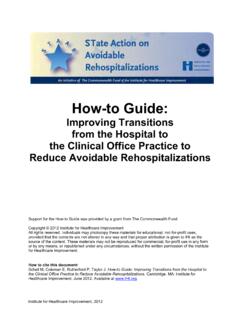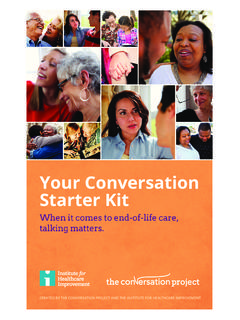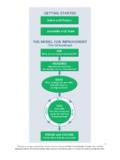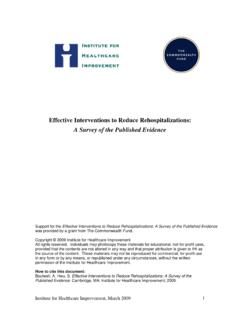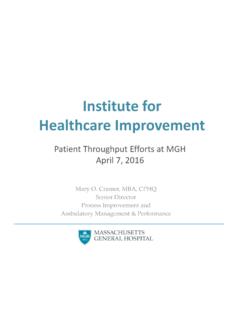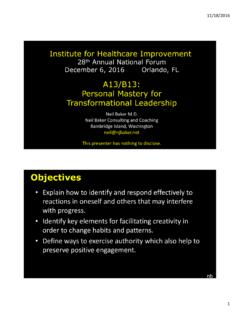Transcription of Improving Clinical Communication using SBAR
1 Improving Clinical Communication using SBAR guide has been produced by Julie would particularly like to thank healthcare organisations in Wales and their teams for their work in implementing this intervention and also feeding back lessons and experiences gained as a result. All of the example templates have been produced by NHS organisations in Lives Plus is run as a collaborative, involving the National Leadership and Innovation Agency for healthcare , the National Patient Safety Agency, Public Health Wales and the Welsh Assembly s Clinical Governance Support and Development wish to thank and acknowledge the institute for healthcare improvement (IHI) and the Health Foundation for their support and contribution to 1000 Lives Plus.
2 Date of publicationThis guide was published in 2011 and will be reviewed in 2012. The latest version will always be available online at purpose of this guideThis guide has been produced to enable healthcare organisations and their teams to successfully implement a series of interventions to improve the safety and quality of care that their patients Tools for improvement guides are also available to support you in your improvement work: How to Improve How to use the Extranet A Guide to Mortality Measurement How to use Trigger Tools Reducing Patient Identification ErrorsThese are available from the 1000 Lives Plus office, or online at are grateful to The Health Foundation for their support in the production of this Clinical Communication using SBAR Improving care, delivering qualityThe 1000 Lives Campaign has shown what is possible when we are united in pursuit of a single aim: the avoidance of unnecessary harm for the patients we serve.
3 The enthusiasm, energy and commitment of teams to improve patient safety by following a systematic, evidence-based approach has resulted in many examples of demonstrable safety , as we move forward with 1000 Lives Plus, we know that harm and error continue to be a fact of life and that this applies to health systems across the world. We know that much of this harm is avoidable and that we can make changes that reduce the risk of harm occurring. Safety problems can t be solved by using the same kind of thinking that created them in the first place. To make the changes we need, we must build on our learning and make the following commitments: Acknowledge the scope of the problem and make a clear commitment to change systems.
4 Recognise that most harm is caused by bad systems and not bad people. Acknowledge that Improving patient safety requires everyone on the care team to work in partnership with one another and with patients and national vision for NHS Wales is to create a world-class health service by 2015: one which minimises avoidable death, pain, delays, helplessness and waste. This guide will help you to take a systematic approach and implement practical interventions that can bring that about. The guide is grounded in practical experience and builds on learning from organisations across Wales during the 1000 Lives Campaign and also on the experience of other campaigns and improvement work supported by the institute for healthcare improvement (IHI).
5 Where reference is made to 1000 Lives Plus, this includes the work undertaken as part of the 1000 Lives Campaign and the second phase of this improvement programme 1000 Lives guide uses examples from the former NHS organisational structures, and where possible this has been Lives Plus 14 Cathedral Road, Cardiff CF11 9LJ | Tel: (029) 2022 7744 Email: | Web: : Clinical Communication using SBAR 5 What is SBAR? 6 How to use SBAR to improve Clinical Communication 10 Helpful resources 21 References 22 Bibliography Clinical Communication using SBAR IntroductionSince the launch of the 1000 Lives Campaign in April 2008, the use of SBAR as a Communication tool has been tested by all secondary care organisations in Wales.
6 The majority of testing has been in conjunction with the use of Track and Trigger tools. The tool can be used to shape Communication at any stage of the patient s journey, from the content of a GP referral letter, consultant to consultant referrals, and discharge back to the GP. Corporate use of the SBAR structure also provides a consistent approach to the information the organisation is receiving. During an episode of care, a patient can potentially be treated by a number of healthcare practitioners and specialists in multiple settings, including primary care, specialised outpatient care, emergency care, surgical care, intensive care, and rehabilitation.
7 Additionally, patients will often move between areas of diagnosis, treatment, and care on a regular basis and may encounter three shifts of staff each day introducing a safety risk to the patient at each hand-over Communication between units and amongst care teams might not include all the essential information, or information may be misunderstood. These gaps in Communication can cause serious breakdowns in the continuity of care, inappropriate treatment, and potential harm to the Communication relates to the process of passing patient-specific information from one caregiver to another, from one team of caregivers to the next, or from caregivers to the patient and family for the purpose of ensuring patient care continuity and Communication also relates to the transfer of information from one type of healthcare organisation to another, or from the healthcare organisation to the patient s home.
8 Information shared usually consists of the patient s current condition, recent changes in condition, ongoing treatment and possible changes or complications that might occur. Patient care hand-overs occur in many settings across the spectrum of care, including admission from primary care, transfer of clinician to another speciality, nursing change-of-shift reporting, nursing report on patient transfer between units or facilities, anaesthetic reports to post operative recovery room staff, emergency department Communication with staff at a receiving unit during a patient s transfer, and discharge of the patient back home or to another care Safety Solutions, volume 1, solution 3/ May 2007 World Health Organization Clinical Communication using SBAR is SBAR?
9 SBAR - Situation-Background-Assessment-Recommen dation SBAR is an easy to remember mechanism that you can use to frame conversations, especially critical ones, requiring a clinician s immediate attention and action. It enables you to clarify what information should be communicated between members of the team, and how. It can also help you to develop teamwork and foster a culture of patient safety. Utilised extensively in medicine, and originating from the nuclear submarine service, SBAR stands for:S Situation: What is happening at the present time?B Background: What are the circumstances leading up to this situation?A Assessment: What do I think the problem is?
10 R Recommendation: What should we do to correct the problem?The tool consists of standardised prompt questions within four sections, to ensure that staff are sharing concise and focused information. It allows staff to communicate assertively and effectively, reducing the need for repetition. The tool helps staff anticipate the information needed by colleagues and encourages assessment skills. using SBAR prompts staff to formulate information with the right level of of information is vital to the safety of the move to shift patterns, which increase the number of individuals caring for patients, the need for comprehensive handover of Clinical information is more important than hand-over does not happen by chance.










